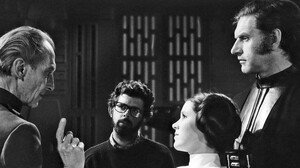George Lucas (1973-1983)

George Lucas’s early career represents one of the most transformative periods in film history. Rising from the indie-like roots of American Graffiti to creating the galaxy-spanning phenomenon of Star Wars, Lucas revolutionized the industry through his storytelling, technical innovation, and business acumen. While he “directed” only four films in this period, their cumulative impact reshaped the possibilities of modern cinema, both creatively and commercially. Lucas’s strengths as a world-builder and innovator, driven by his preference for broad archetypes and technological experimentation over nuanced character development, often overshadow his accomplishments as a traditional filmmaker. Nevertheless, Lucas’s work during this era reflects a singular vision that altered the cinematic landscape forever.
American Graffiti (1973) Lucas’s breakthrough feature, American Graffiti, stands as a heartfelt homage to 1960s small-town Americana and the fading innocence of youth. Set over the course of one night, the film follows a group of teenagers navigating the uncertainty of their futures while cruising through Modesto, California. The film’s strength lies in its authenticity, with the filmmaker drawing from his own experiences to craft a narrative that feels deeply personal, yet universal. The ensemble cast, including Richard Dreyfuss, Ron Howard, and Harrison Ford, deliver naturalistic performances that ground the film’s nostalgia in genuine emotion. But what truly sets American Graffiti apart is its groundbreaking use of music. The wall-to-wall soundtrack of rock-and-roll hits is not merely accompaniment but an integral part of the storytelling, creating a sense of time and place that resonates with the viewer. The film’s success—both critical and commercial—proved Lucas could craft compelling human stories before embarking on his galaxy-spanning epics.
Star Wars (1977) With Star Wars (later retitled Star Wars: Episode IV – A New Hope), Lucas changed the course of cinematic history. Drawing on influences ranging from Akira Kurosawa’s The Hidden Fortress to the Flash Gordon serials of his youth, Lucas created a modern myth that captured the imaginations of millions. The film’s success owes much to its simplicity, and its archetypal story of good versus evil, which when combined with relatable characters like Luke Skywalker, Princess Leia, and Han Solo, made the fantastical galaxy far, far away accessible to audiences of all ages. For certain, Lucas’s true genius lay in his attention to world-building. The lived-in aesthetic of his universe, complete with intricate designs for ships, droids, and alien species, lends the film a sense of realism that sets it apart from the glossy sci-fi of the era. The technical achievements of Star Wars cannot be overstated. From the groundbreaking special effects developed by Industrial Light & Magic to John Williams’s iconic score, Lucas surrounded himself with talent that elevated his vision. The result was a phenomenon that not only dominated the box office but also reshaped Hollywood, ushering in the era of the blockbuster.
The Empire Strikes Back (1980) While Lucas stepped away from the directing duties for The Empire Strikes Back, his creative fingerprints are all over the film. Directed by Irvin Kershner and written by Leigh Brackett and Lawrence Kasdan, the sequel deepened the mythology of the Star Wars universe while delivering one of the most beloved films of all time. Lucas’s decision to make this installment darker and more character-driven proved to be a masterstroke. The film explores themes of loss, betrayal, and destiny, all while expanding the lore with memorable additions like Yoda, Lando Calrissian, and the icy landscapes of Hoth. The film’s emotional resonance reaches its peak in the climactic revelation of Darth Vader’s true identity. This twist not only shocked audiences but recontextualized the entire saga, cementing Lucas’s reputation as a master storyteller. The Empire Strikes Back is widely regarded as the crown jewel of the Star Wars series, a testament to Lucas’s ability to balance spectacle with substance.
Return of the Jedi (1983) Return of the Jedi brought Lucas’s original trilogy to a close, delivering a satisfying conclusion to the story of Luke Skywalker’s journey and the battle against the Empire. Directed by Richard Marquand, the film features some of the saga’s most iconic moments, including the rescue of Han Solo from Jabba the Hutt and the final confrontation between Luke, Darth Vader, and the Emperor. In the end, Lucas’s fingerprints are more evident here, and the film’s strengths—such as the thrilling space battle above Endor and the emotional redemption of Darth Vader—are offset by its reliance on commercial elements like the Ewoks, seen by fans as his pandering to younger audiences. While Return of the Jedi lacks the depth and innovation of its predecessors, it succeeds in tying up loose ends and providing a sense of closure. The film’s enduring popularity is a testament to Lucas’s skill in crafting narratives that resonate with audiences, even when creative compromises are evident.
Overall Appraisal Between 1973 and 1983, George Lucas transformed himself from a promising filmmaker into a cinematic titan. American Graffiti showcased his ability to craft deeply personal stories, while the Star Wars trilogy revolutionized blockbuster filmmaking. Lucas’s contributions to special effects, sound design, and film merchandising set new industry standards, influencing generations of filmmakers. Yet, Lucas’s reliance on archetypes and his occasional preference for spectacle over character development reveal his limitations. His films often lack the emotional nuance of his peers, relying instead on broad strokes to tell his stories. Even so, this simplicity is part of what made his work so universally appealing. Lucas’s greatest strength lies in his vision. He saw filmmaking not just as an art form but as a technological frontier, pushing the boundaries of what was possible and setting the stage for the digital revolution that would follow. His legacy from this era is not just the films he made but the ways in which he changed the method movies are created and consumed. While Lucas’s later career would prove divisive, his work from 1973 to 1983 remains a towering achievement. The films of this period are not just essential; they are cultural touchstones, beloved by audiences and revered by filmmakers alike.
